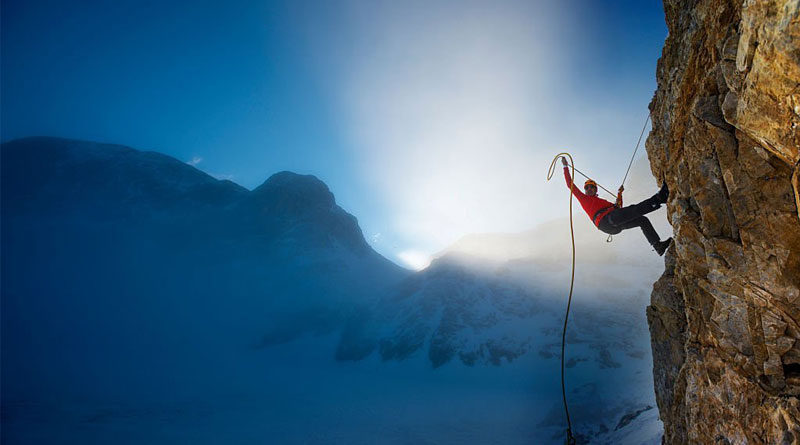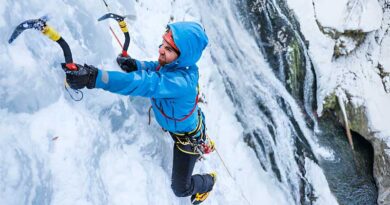Mountaineering vs. Rock Climbing: The Differences
Mountaineering and rock climbing are both outdoor activities. Both of these activities involve climbing and ascending various terrains but they differ in several ways.
Mountaineering or mountain climbing is a multi-disciplinary sport that incorporates hiking, climbing, and even skiing on mountains. It usually involves ascending a mountain’s summit and can take several days or weeks to finish. Mountaineers often navigate steep and rough terrain using ropes, harnesses, and other safety equipment. The emphasis is on reaching the peak and experiencing a remote, high-altitude environment.
Rock climbing, on the other hand, requires climbing skills and gear to scale natural rock formations or artificial walls. Rock climbers often take shorter, steeper routes and are more concerned with the technical challenge of the climb than with reaching the peak. A rock climbing trip is usually short and you can even complete it in a day. It can be done on natural rock formations or manmade climbing walls.
Physical Demands
Mountain climbing needs a high level of physical endurance due to the long hikes, steep ascents, and carrying hefty packs. You need to cope with high altitudes and adverse weather. You also need to prepare yourself for carrying heavy loads. Endurance and physical fitness are important aspects of mountain climbing success.
You also need physical strength and endurance for rock climbing but the demands are slightly different. You must hold onto and climb small holds while maintaining body position over extended periods. It can involve upper body strength, core stability, and grip strength. Rock climbing routes, unlike mountain climbing, are often shorter and can be finished in a day or so. However, they may still involve prolonged physical effort.
Technical Demands
Mountain climbing requires technical skills in rope work, anchor building, and belaying. You need to navigate steep and difficult terrain. You also need to use ice axes and crampons to traverse glaciers and snowfields. Mountain climbers must have a good understanding of self-arrest and other safety techniques in case of a fall.
Rock climbing requires a comprehensive understanding of technical climbing skills, such as movement tactics, route finding, and equipment usage. You need to master the belaying and rappelling technique and the use of specialist equipment such as quickdraws and carabiners. Climbers must determine the best method to navigate the rock and reach the top, which requires a great degree of problem-solving.
Equipment Considerations
Rock and mountain climbing require different types of equipment and you need to consider them before attempting any of these activities.
Mountain Climbing
Mountain climbing requires the following equipment.
- Climbing Ropes: You need strong and durable ropes as they are must-have equipment for mountain climbing. They provide critical safety support during the ascent and descent.
- Harnesses: You also need a comfortable and adjustable harness. It is necessary for mountain climbing, as it provides support and a secure connection to the rope.
- Carabiners: You need strong and durable carabiners for clipping into anchors and building belays.
- Crampons: For climbing on glaciers and snowfields, you will need crampons to provide traction.
- Ice Axes: Ice axes are used for self-arrest and balance on steep, icy slopes.
- Backpacks: You will need a mountaineering backpack to carry your gear.
- Sleeping gear: You might need a tent, sleeping bag, and sleeping pad depending on how long the climb is.
- Climbing Helmet: A helmet is a crucial piece of safety equipment for mountain climbing. It protects in the event of falling.
Keep the above-mentioned gear handy for a successful mountaineering experience.
Rock Climbing
Rock climbing requires the following equipment:
- Climbing Ropes: You will need strong and durable ropes for safety.
- Harnesses: You will also need a harness for support and a secure connection to the rope.
- Climbing Shoes: Stiff, supportive climbing shoes are a must for rock climbing. They provide the precision and grip needed for navigating small holds.
- Quickdraws: Rock climbers use quickdraws to clip into anchors and protect against falls.
- Chalk: Chalk helps you maintain a grip on small holds and prevents sweat from affecting your grip.
- Carabiners: You will need several carabiners for clipping into anchors and building belays.
- Climbing Helmets: Like mountaineers, rock climbers also need a helmet. It protects your head from falling debris and injury in the case of a fall.
Keep the above-mentioned gear handy for a successful rock climbing experience.
Safety Considerations
There are also different safety considerations for both activities and they are as follows.
Mountain Climbing
Mountain climbing requires the following safety considerations.
- Altitude Sickness: You can get altitude sickness if you climb to a high altitude too quickly. You must be aware of the symptoms and take steps to acclimate to the altitude.
- Weather: Mountain climbing often takes place in remote and exposed environments. High winds, intense lightning, and a lot of snow are all possible during the mountain’s harsh weather conditions.
- Avalanche Risk: In some mountain environments, the risk of avalanches can be pretty high. It is a rapid flow of snow down a slope, such as a hill or a mountain.
- Rockfall: Falling rocks and other debris can be a hazard on steep mountain slopes. You should always wear helmets for protection.
- Glacier Travel: Climbing on glaciers requires specialized skills and equipment. So, keep an eye on the risks associated with crevasses and other hazards.
So, these are the safety consideration that you should keep in mind when climbing a mountain.
Rock Climbing
Rock climbing requires the following safety considerations.
- Falling: Rock climbing involves a risk of falling. You must be properly trained in belaying and other safety techniques to minimize this risk.
- Equipment Failure: Your gear such as your harness or rope can fail at any time. So, check your gear for any damaged or worn-out parts to minimize the risk of equipment failure.
- Rock Quality: The quality of the rock can affect the safety of a climb. So, it is better to find out the potential weaknesses or hazards in the rock you are attempting to climb.
- Route Finding: Master the techniques of assessing and navigating routes because taking the wrong path can lead to dangerous situations.
So, keep these risks associated with rock climbing in mind.
Types of Terrain
Mountain climbing involves ascending greater elevations, such as mountains, peaks, and glaciers. Snow and ice, steep rock faces, loose, unstable rock, and dirt are just a few of the mountain terrains. You use specialized gear such as crampons, ice axes, and ropes to navigate these terrains. You will also use skills like belaying and ice climbing techniques. Rock climbing involves climbing up, down, or across the rock face. It is typically done on large rock formations, such as cliffs or boulders. Smooth, sheer surfaces and rough, uneven rock formations with crevices, cracks, and ledges are both possible climbing terrains. Rock climbers employ a number of maneuvers to get across the terrain, including grip strength, footwork, and balance.
Mountaineering vs. Mountain Climbing
Mountaineering and mountain climbing are often used interchangeably but they are slightly different terms.
The activity of climbing mountains and reaching their summit while using climbing gear and expertise is known as mountain climbing. It is also called a subclass of mountaineering. Mountain climbing includes a wider range of pursuits and expertise in moving about and discovering high terrain.
In contrast, mountaineering is a sport that combines hiking, climbing, and sometimes skiing. It can also involve other pursuits like snowboarding, glacier travel, and ice climbing. It is a multi-disciplinary sport that often takes place in isolated and high-altitude settings. Mountaineering can last for several days or weeks.




